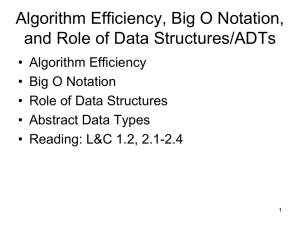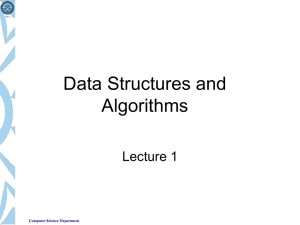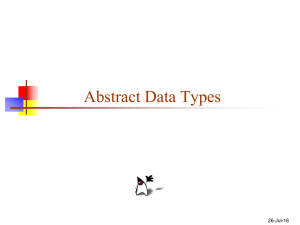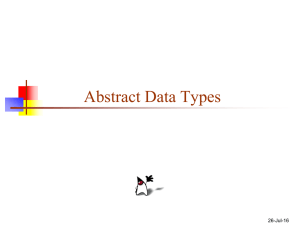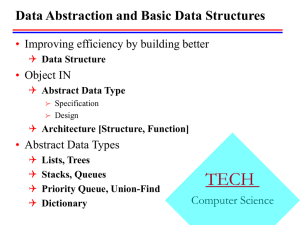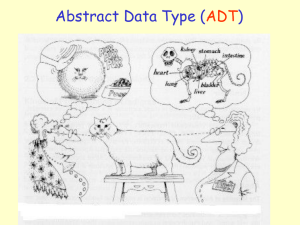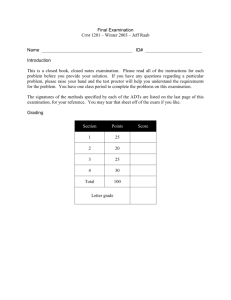Algorithm Efficiency, Big O Notation, and Role of data Structures
advertisement
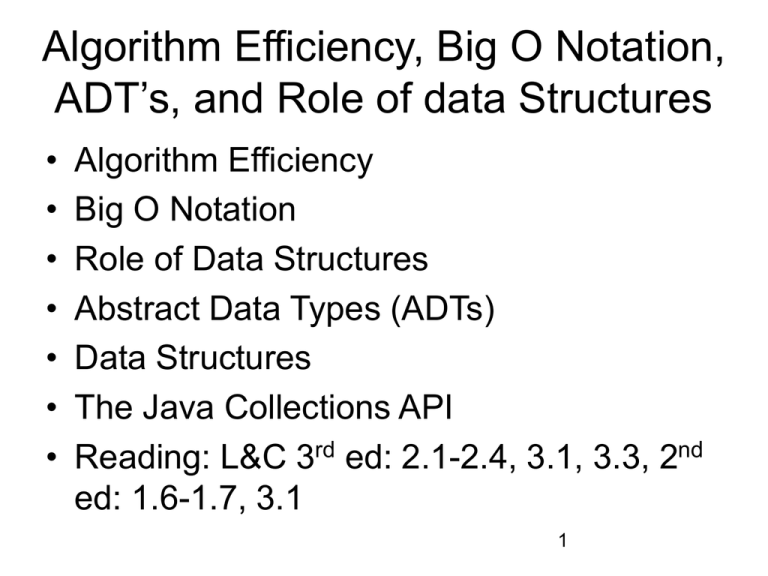
Algorithm Efficiency, Big O Notation,
ADT’s, and Role of data Structures
•
•
•
•
•
•
•
Algorithm Efficiency
Big O Notation
Role of Data Structures
Abstract Data Types (ADTs)
Data Structures
The Java Collections API
Reading: L&C 3rd ed: 2.1-2.4, 3.1, 3.3, 2nd
ed: 1.6-1.7, 3.1
1
Algorithm Efficiency
• Let’s look at the following algorithm for
initializing the values in an array:
final int N =
int [] counts
for (int i=0;
counts[i]
500;
= new int[N];
i<counts.length; i++)
= 0;
• The length of time the algorithm takes to
execute depends on the value of N
2
Algorithm Efficiency
• In that algorithm, we have one loop that
processes all of the elements in the array
• Intuitively:
– If N was half of its value, we would expect the
algorithm to take half the time
– If N was twice its value, we would expect the
algorithm to take twice the time
• That is true and we say that the algorithm
efficiency relative to N is linear
3
Algorithm Efficiency
• Let’s look at another algorithm for initializing the
values in a different array:
final int N = 500;
int [] [] counts = new int[N][N];
for (int i=0; i<N; i++)
for (int j=0; j<N; j++)
counts[i][j] = 0;
• The length of time the algorithm takes to
execute still depends on the value of N
4
Algorithm Efficiency
• However, in the second algorithm, we
have two nested loops to process the
elements in the two dimensional array
• Intuitively:
– If N is half its value, we would expect the
algorithm to take one quarter the time
– If N is twice its value, we would expect the
algorithm to take quadruple the time
• That is true and we say that the algorithm
efficiency relative to N is quadratic
5
Big-O Notation
• We use a shorthand mathematical notation to
describe the efficiency of an algorithm relative
to any parameter n as its “Order” or Big-O
– We can say that the first algorithm is O(n)
– We can say that the second algorithm is O(n2)
• Let T(n) be a function that formulates the time
an algorithm needs to be completed, where n is
the parameter that specifies the size of the
problem, we say that the algorithm is O(T(n))
[or the algorithm has the time-complexity
of
6
O(T(n))].
Big-O Notation
•
Big-O notation measures how fast the
the running time of the algorithm grows
with increase in the size of the problem
, not how long will it take for our
algorithm to run as a function of the
size of the problem. Therefore,
– We only include the fastest growing term and
ignore any multiplying by or adding of
constants. Since they are not dependent on
the size of the problem.
7
– If our time growth function has multiple terms
Seven Growth Functions
• Eight functions O(n) that occur frequently
in the analysis of algorithms (in order of
increasing rate of growth relative to n):
– Constant 1
– Logarithmic log n
– Linear n
– Log Linear n log n
– Quadratic n2
– Cubic n3
– Exponential 2n
– Factorial n!
8
Growth Rates Compared
1
n=1 n=2 n=4 n=8
1
1
1
1
n=16
1
n=32
1
logn
0
1
2
3
4
5
n
1
2
4
8
16
32
nlogn 0
2
8
24
64
160
n2
1
4
16
64
256
1024
n3
1
8
64
512
4096
32768
2n
2
4
16
256
65536
4294967296
n!
1
2
24
40320 2.09e+13 2.63e+35
9
Big-O for a Problem
• O(T(n)) for a problem means there is some
O(T(n)) algorithm that solves the problem
• Don’t assume that the specific algorithm that
you are currently using is the best solution for
the problem
• There may be other correct algorithms that
grow at a smaller rate with increasing n
• Many times, the goal is to find an algorithm
with the smallest possible growth rate
10
Data Structures
• That brings up the topic of the Data
structure on which the algorithm operates.
• Data Structure is a particular way of
organizing the data in computer memory
so that it can be used efficiently.
11
Role of Data Structures
If we are using an algorithm manually on
some amount of data, we intuitively try to
organize the data in a way that minimizes
the number of steps that we need to take.
As an example, publishers offer
dictionaries with the words listed in
alphabetical order to minimize the length
of time it takes us to look up a word.
12
Role of Data Structures
• We can do the same thing for algorithms in
our computer programs
• Example: Finding a numeric value in a list
– If we assume that the list is unordered, we must
search from the beginning to the end
– On average, we will search half the list
– Worst case, we will search the entire list
– Algorithm is O(n), where n is size of array or list.
13
Role of Data Structures
• Find a match with value in an unordered list
int [] list = {7, 2, 9, 5, 6, 4};
for (int i=0; i<list.length, i++)
if (value == list[i])
return true; // found it
return false; //did not find it.
14
Role of Data Structures
• If we assume that the list is ordered, we can
still search the entire list from the beginning
to the end to determine if we have a match
• But, we do not need to search that way
• Because the values are in numerical order,
we can use a binary search algorithm
• Like the old parlor game “Twenty Questions”
• Algorithm is O(log2n), where n is size of array
15
Role of Data Structures
• Find a match with value in an ordered list
int [] list = {2, 4, 5, 6, 7, 9};
int min = 0, max = list.length-1;
while (min <= max) {
if (value == list[(min+max)/2])
return true; // found it
else
if (value < list[(min+max)/2])
max = (min+max)/2 - 1;
else
min = (min+max)/2 + 1;
}
return false;
// didn’t16find it
Role of Data Structures
• The difference in the structure of the data
between an unordered list and an ordered
list can be used to reduce algorithm Big-O
• This is the role of data structures and why
we study them
• We need to be as clever in organizing our
data efficiently as we are in designing an
algorithm for processing it efficiently. In fact
we can not separate one task from another.
17
Abstract Data Types (ADT’s)
• A data type is a set of values and operations
that can be performed on those values.
• The Java primitive data types (e.g. int) have
values and operations defined in Java itself.
• An Abstract Data Type (ADT) is a (usually
more sophisticated) data type that has values
and operations that are not defined in the
language itself. Instead, in Java, an ADT is
implemented using a class or an interface.
18
Abstract Data Types (ADT’s)
• The code for Arrays.sort is designed to sort
an array of Comparable objects:
public static void sort (Comparable [ ] data)
• The Comparable interface defines an ADT
• There are no objects of Comparable “class”
• There are objects of classes that implement
the Comparable interface.
• Arrays.sort only uses methods defined in the
Comparable interface, i.e. compareTo().
19
ADT’s and Data Structures
• Data structures are used to implement an
Abstract Data Type. A data structure is used
to:
– to organize the data that the ADT is
encapsulating.
• The type of data structure should be hidden
Interface (ADT)
by the API (the methods) of the ADT.
Class that
uses
an ADT
Class that
implements
an ADT
Data
Structure
20
Collections
• A collection is a typical example of Abstract
Data Type.
• A collection is a data type that contains and
allows access to a group of objects.
• The Collection ADT is the most general form of
ADTs designed for containing/accessing a
group of objects.
• We have more specific forms of Collection
ADTs which describe the access “strategy” that
21
models that collection:
The Java Collections API
• The classes and interfaces in the Java
Collections Library are named to indicate
the underlying data structure and the
abstract Data type.
• For example, the ArrayList we studied in
CS110 uses an underlying array as the data
structure for storing its objects and
implements its access model as a list
• However, from the user’s code point of view,
22
the data structure is hidden by the
API.
23
